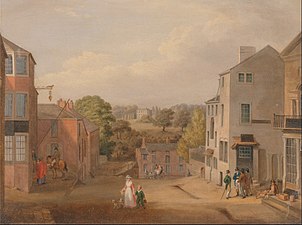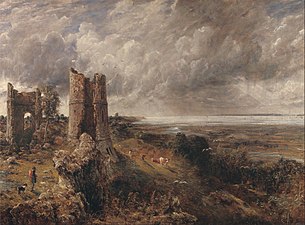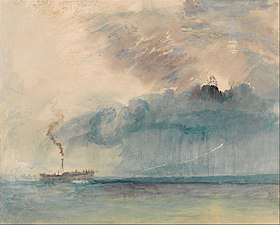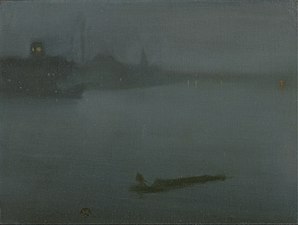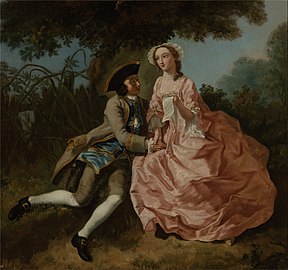-
The Stables and Two Famous Running Horses belonging to His Grace, the Duke of Bolton, by James Seymour, 1747
-
A Lion Attacking a Horse, by George Stubbs, 1762
-
Whitehall, by William Marlow, 1775
-
Street Scene in Chorley, Lancashire, with a view of Chorley Hall, by John Bird of Liverpool, c. 1795
-
Harwich Lighthouse, by John Constable, 1820
-
A Paddle-steamer in a Storm, watercolor by J. M. W. Turner, c. 1841
-
Nocturne in Blue and Silver, by James Abbott McNeill Whistler, c. 1872-1878
This article needs additional citations for verification. (March 2016) |
| Yale Center for British Art | |
|---|---|
 The Yale Center for British Art at Yale University (2024) | |
 Interactive fullscreen map | |
| General information | |
| Type | Art museum, Rare Book Library, Institute, Art center[1] |
| Architectural style | Modern |
| Location | New Haven, Connecticut |
| Address | 1080 Chapel Street |
| Coordinates | 41°18′28.469″N 72°55′51.262″W / 41.30790806°N 72.93090611°W |
| Completed | 1974 |
| Technical details | |
| Structural system | Concrete frame |
| Design and construction | |
| Architect(s) | Louis Kahn |
| Other information | |
| Public transit access | |
| Website | |
| britishart.yale.edu | |
The Yale Center for British Art at Yale University in central New Haven, Connecticut, houses the largest and most comprehensive collection of British art outside the United Kingdom.[2] The collection of paintings, sculpture, drawings, prints, rare books, and manuscripts reflects the development of British art and culture from the Elizabethan period onward.
Creation
[edit]The center was established by a gift from Paul Mellon (Yale College Class of 1929) of his British art collection to Yale in 1966, together with an endowment for operations of the center, and funds for a building to house the artworks. The building was designed by Louis I. Kahn and constructed at the corner of York and Chapel Streets in New Haven, across the street from one of Kahn's earliest buildings,[3] the Yale University Art Gallery, built in 1953.
The Yale Center for British Art was completed after Kahn's death in 1974, and opened to the public on April 15, 1977. The exterior is made of matte steel and reflective glass; the interior is made of travertine marble, white oak, and Belgian linen. Kahn succeeded in creating intimate galleries where one can view objects in diffused natural light. He wanted to allow in as much daylight as possible, with artificial illumination used only on dark days or in the evening. The building's design, materials, and sky-lit rooms combine to provide an environment for the works of art that is simple and dignified.[4]
The center is affiliated with the Paul Mellon Centre for Studies in British Art in London, which awards grants and fellowships, publishes academic titles, and sponsors Yale's first credit-granting undergraduate study abroad program, Yale-in-London.[5]
Collection
[edit]The collection consists of nearly 2,000 paintings and 200 sculptures, with an emphasis on the period between William Hogarth's birth (1697) to J. M. W. Turner's death (1851). Other artists represented include Thomas Gainsborough, George Stubbs, Joseph Wright, John Constable, Joshua Reynolds, Thomas Lawrence, Francis Danby, Robert Polhill Bevan, Stanley Spencer, Barbara Hepworth, and Ben Nicholson.


The collection also has works by artists from Europe and North America who lived and worked in Britain. These include Hans Holbein, Peter Paul Rubens, Anthony van Dyck, Canaletto, Johann Zoffany, John Singleton Copley, Benjamin West, and James McNeill Whistler.
Some areas of emphasis of the collection are small group portraits, known as "conversation pieces", including those by Hogarth, Gainsborough, Johan Zoffany and Arthur Devis; landscape paintings by Gainsborough, Richard Wilson, Constable, Richard Parkes Bonington and Turner; and British sporting and animal paintings, featuring George Stubbs, John Wootton, Benjamin Marshall, and Alfred Munnings. Other genres include marine paintings, represented by Samuel Scott and Charles Brooking; London cityscapes; travel art from India, scenes of Shakespearean plays, and portraits of actors.
Sculptors represented include Louis-Francois Roubiliac, Joseph Nollekens, Francis Chantrey, Jacob Epstein, and Henry Moore.
The collection of 20,000 drawings and watercolors and 31,000 prints features British sporting art and figure drawings. It includes works by Hogarth, Paul Sandby, Thomas Rowlandson, William Blake, John Constable, Samuel Palmer, Richard Parkes Bonington, John Ruskin, J. M. W. Turner, Walter Sickert, Duncan Grant, Paul Nash, Edward Burra, Stanley Spencer, Augustus John, Gwen John, and the Pre-Raphaelites.
The center's collection of rare books and manuscripts comprises 35,000 volumes, including maps, atlases, sporting books, and archival material of British artists. It also has some 1,300 leaves originating in illustrated incunabula. The collection also includes a complete set of William Morris's Kelmscott Press publications as well as a growing collection of contemporary artists' books. The core of the collection of illustrated books is the material amassed by Major J. R. Abbey‚ one of the first collectors of British color-plate books, and includes more than 2‚000 volumes describing British life‚ customs‚ scenery‚ and travel during the period 1770–1860. The center's collection also contains a significant number of early maps and atlases.
The four-floor center offers a year-round schedule of exhibitions and educational programs, including films, concerts, lectures, tours, symposia, and family programs. It also provides numerous opportunities for scholarly research, including residential fellowships. Academic resources of the center include the reference library (40,000 volumes) and photo archive, conservation laboratories, and a study room for examining works on paper from the collection.
The center is open to the public free of charge six days a week, and is a member of the North American Reciprocal Museums program.
Gallery
[edit]-
The Peace embracing the Abundance, Peter Paul Rubens, c. 1632-1633
-
Lovers in a landscape, Petrus Johannes van Reysschoot, c. 1740
-
The Gravenor Family, by Thomas Gainsborough, 1754
-
Portrait of Thomas Gage, by John Singleton Copley, 1768
-
Mrs. Abington as Miss Prue in "Love for Love" by William Congreve, by Sir Joshua Reynolds, 1771
-
A portrait of an Indian Premier Madhavrao Peshwa, an 18th-century Noble, Statesman, Premier
-
Portrait of Benjamin West, by Thomas Lawrence, 1810
-
Portrait of Antonio Canova, by John Jackson, 1820
References
[edit]- ^ Yale Center for British Art: About, ARTINFO, 2008, archived from the original on September 19, 2024, retrieved 2008-07-30
- ^ "Yale Center for British Art". Google art and culture.
- ^ Wainwright, Oliver (11 April 2016). "Yale Center for British Art: deft incisions give Louis Kahn a masterful makeover". The Guardian.
- ^ Lesser, Wendy (28 April 2016). "Whispers of Louis Kahn's Vision at the Yale Center for British Art". The New York Times.
- ^ "Yale Center for British art". The shops at Yale.
External links
[edit]- Official website
- Yale Center for British Art within Google Arts & Culture
 Media related to Yale Center for British Art at Wikimedia Commons
Media related to Yale Center for British Art at Wikimedia Commons







